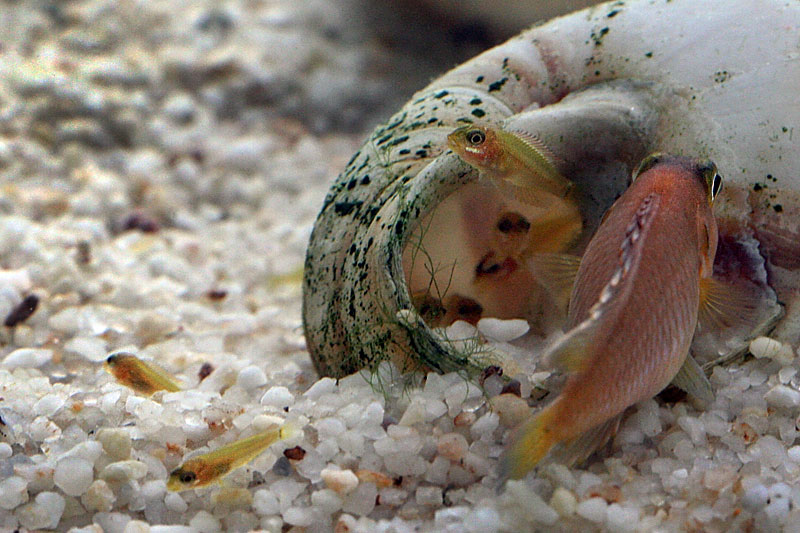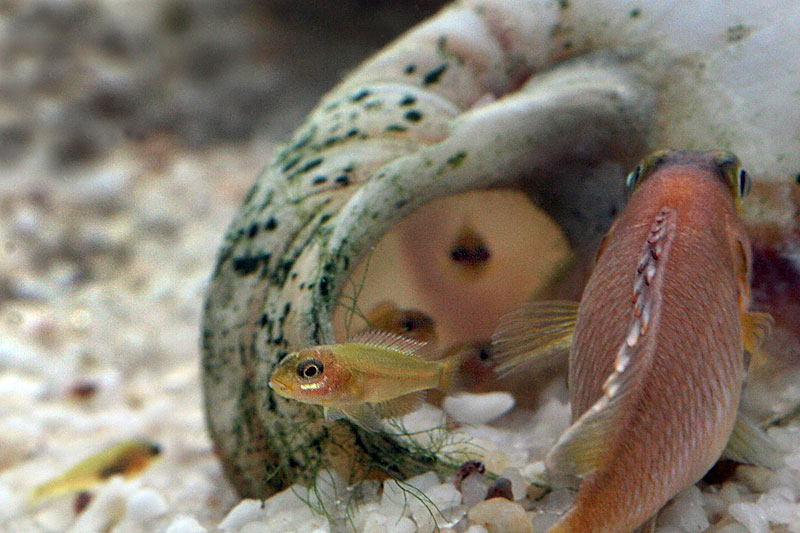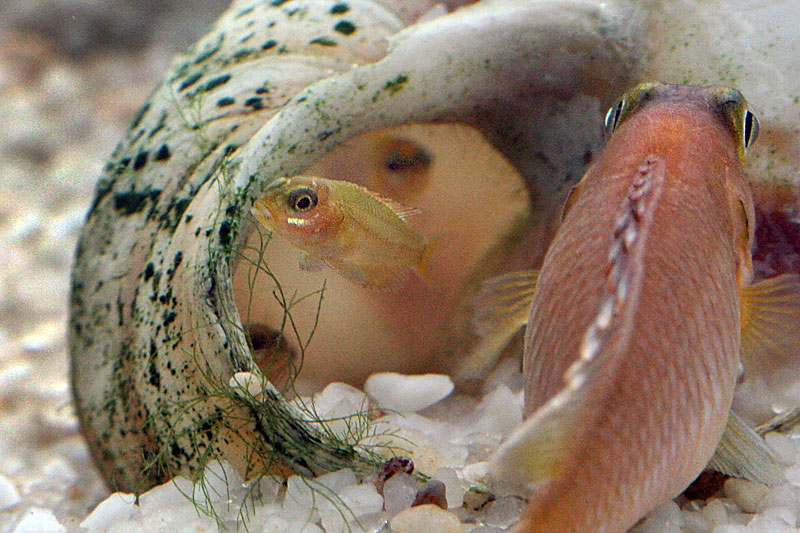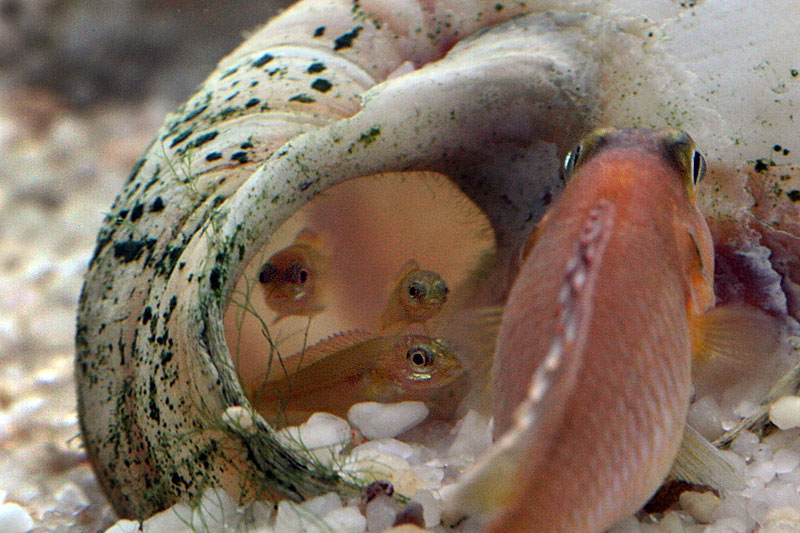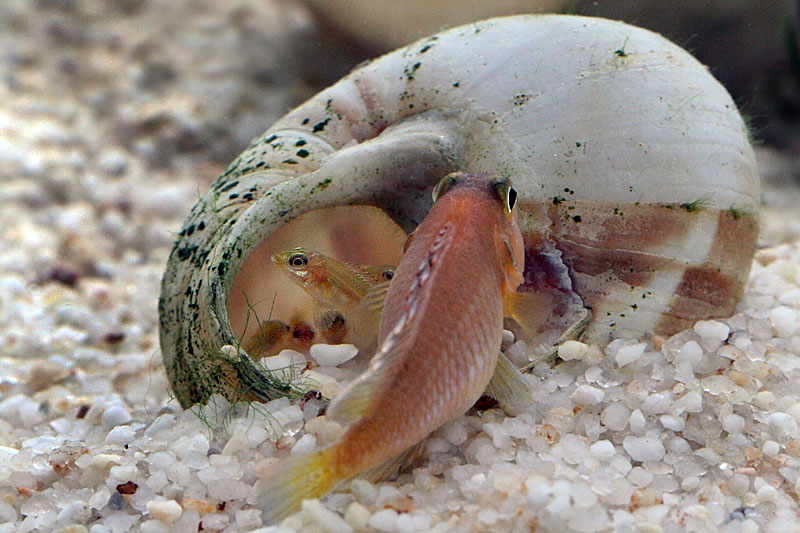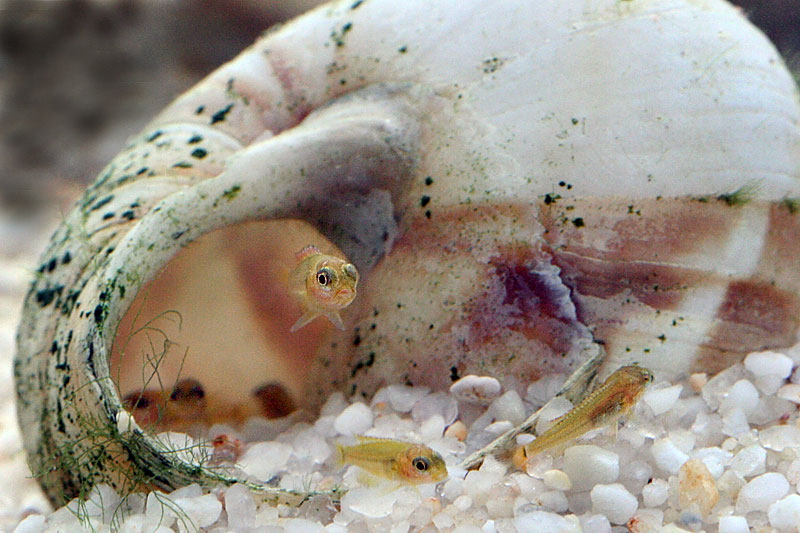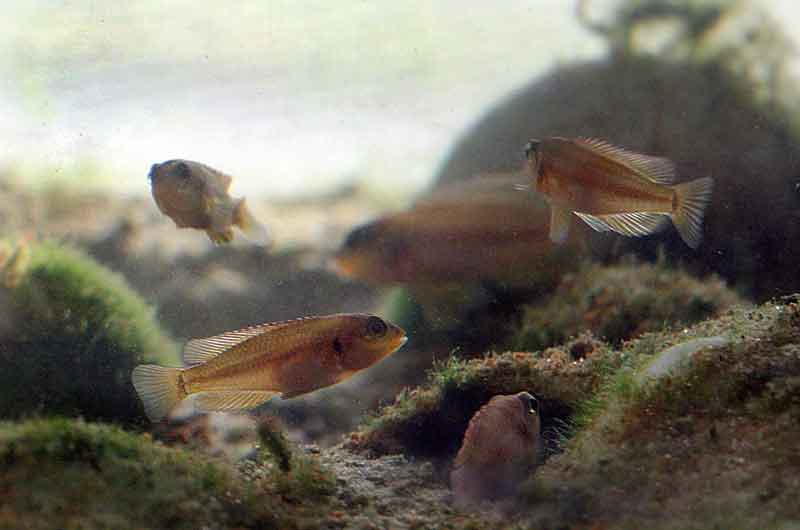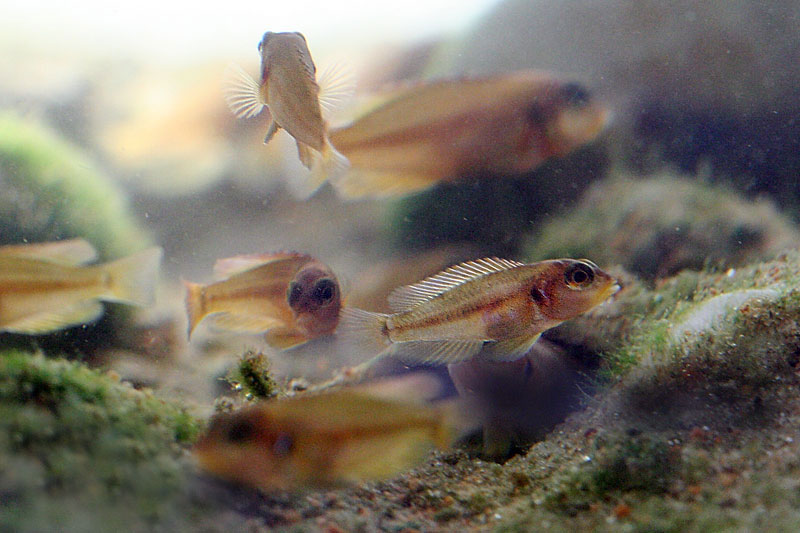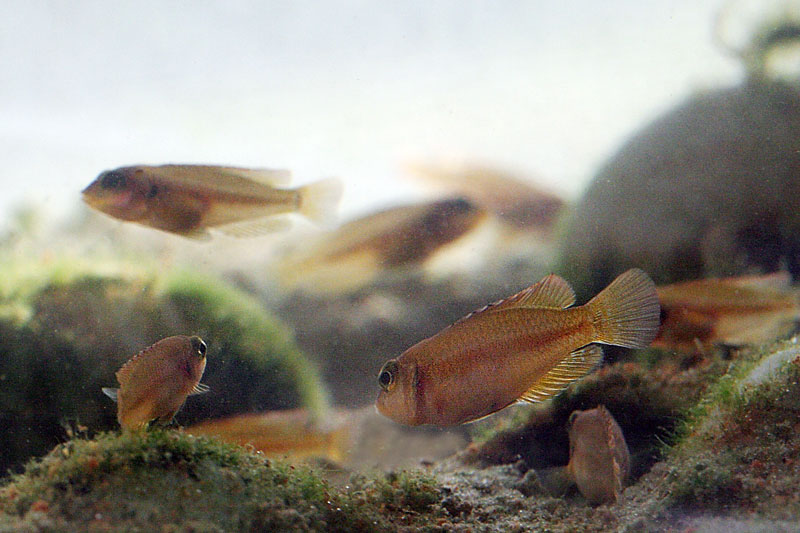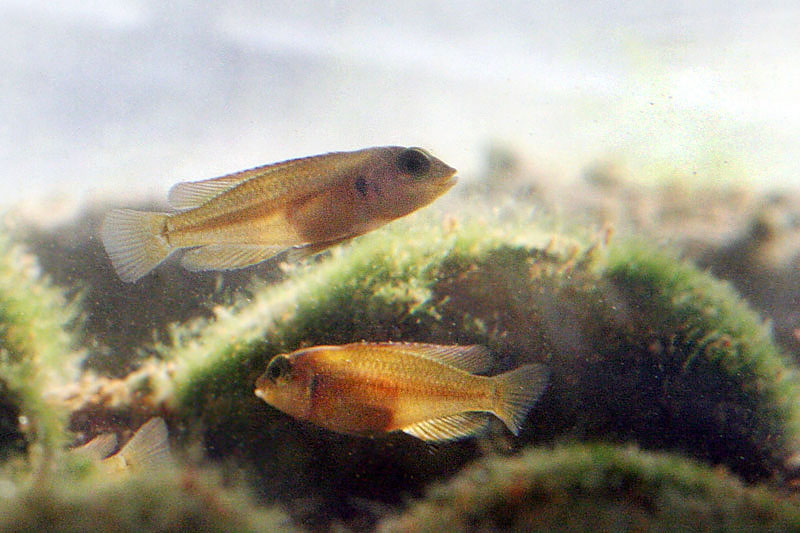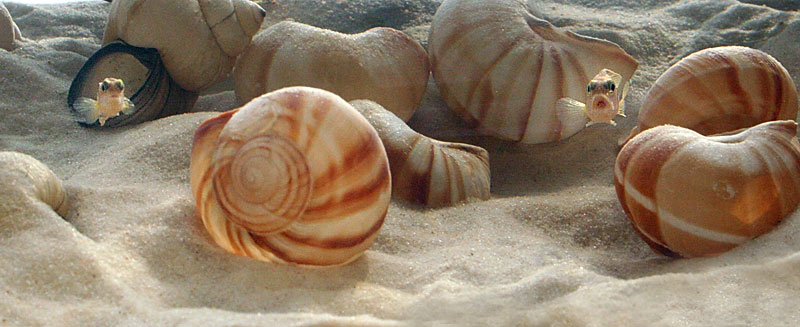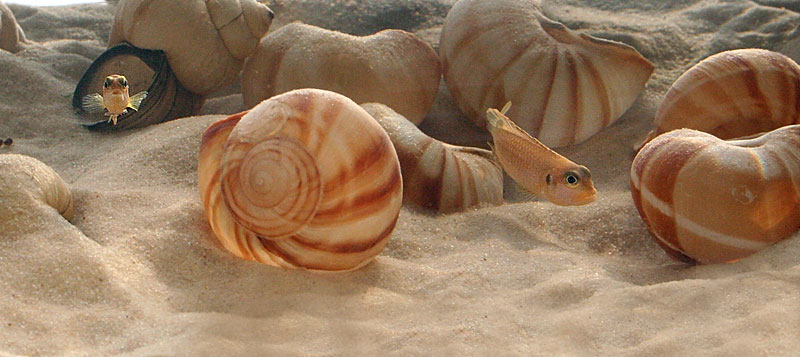5G Fish – Lamprologus occelatus ‘Gold’
 My original pair of occies defending their shells
My original pair of occies defending their shells
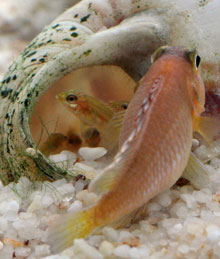 I had kept Lamprologus brevis in my 240G setup for some time. With their 'canine' teeth sticking out and their pretty eyes, brevis are actually quite attractive fish, if you take the time to have a closer look at them. However, from afar they are just little brown things, and I had seen some Lamprologus occelatus 'Gold' that were real eye-catchers with their bright yellow coloration and a metallic blue sheen on the sides. Those were the kinds of shellies I wanted! At the auction as part of the OCA Extravaganza 2006 my son asked me if he could buy some snail shells, and I realized that the bag was labeled "Lamprologus occelatus 'Gold' - pair". I could no longer resist, and I have never regretted the purchase. The occies bred prolifically for me for many years, and selling their fry has never been a problem. Their strong coloration, interesting behavior and suitability to live in small tanks make them enormously attractive for aquaristic experts and beginners alike. One word of caution though, occies do not like to live in colonies like their shell dwelling cousins Lamprologus multifasciatus and Lamprologus similis. Recently in Germany I have heard them being called 'nidifugous' - a term usually applied to birds, but meaning that once the fry grow to a certain size the parents would really prefer to have them out of the house. I would not recommend occies for any tank with a footprint smaller than the one I am using, and even then, only one adult pair will be happy in the tank. Fry have to be removed once they get to a sell-able size of 0.5" to 0.75".
I had kept Lamprologus brevis in my 240G setup for some time. With their 'canine' teeth sticking out and their pretty eyes, brevis are actually quite attractive fish, if you take the time to have a closer look at them. However, from afar they are just little brown things, and I had seen some Lamprologus occelatus 'Gold' that were real eye-catchers with their bright yellow coloration and a metallic blue sheen on the sides. Those were the kinds of shellies I wanted! At the auction as part of the OCA Extravaganza 2006 my son asked me if he could buy some snail shells, and I realized that the bag was labeled "Lamprologus occelatus 'Gold' - pair". I could no longer resist, and I have never regretted the purchase. The occies bred prolifically for me for many years, and selling their fry has never been a problem. Their strong coloration, interesting behavior and suitability to live in small tanks make them enormously attractive for aquaristic experts and beginners alike. One word of caution though, occies do not like to live in colonies like their shell dwelling cousins Lamprologus multifasciatus and Lamprologus similis. Recently in Germany I have heard them being called 'nidifugous' - a term usually applied to birds, but meaning that once the fry grow to a certain size the parents would really prefer to have them out of the house. I would not recommend occies for any tank with a footprint smaller than the one I am using, and even then, only one adult pair will be happy in the tank. Fry have to be removed once they get to a sell-able size of 0.5" to 0.75".
January 2009
Evaporation has always been a bit of an issue with this tank, due to the small volume and the open top setup. I have to refill a little every other day. As long as I am home this is not a problem, since the tank sits right on my desk, so it's not like I might forget about it. However, over X-mas I was in Germany. My larger tanks were fine due to automatic feeders and automatic water change systems, but for my smaller tanks I had a neighbor kid check in occasionally to make sure things were fine. For one reason or another the kid must have completely forgotten to top off this tank. He also overfed, which is easy to do in such a small tank, and when the water level dropped below the top of the sponge filter, biofiltration came to a stop, and my wife - who returned a week earlier than me - came home to a smelling mess. That was the end of my L. occelatus population. When I cleaned up my 240G setup after the vacation, I found that one pair of brevis were defending their shell even more vigorously than usual, and all the usual suspects for fry thievery like leleupi, helianthus, petricola and altos were hanging around that shell. With the certain knowledge that there must be fry in that shell, and a suitable fry grow out tank available, I went ahead and put the shell with mom and kids in the cleaned up 5G. After a few days the mom was put back in the main tank, and the reunification with the male was a sight to behold. I gave them a new, bigger snail shell to celebrate the occasion, and they moved in within minutes! Meanwhile the fry seem to be doing fine in the 5G grow out tank. They are feeding on whatever they can find in a huge ball of Java moss, plus I have started giving them some finely ground pellets. Of course baby brine shrimp would be ideal, but I am lazy and want to see if they can make do without that. So for the time being, this 5G tank has become a brevis grow out tank.
Leave a Reply
You must be logged in to post a comment.
